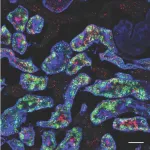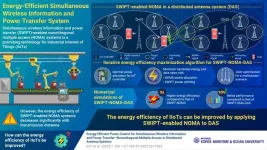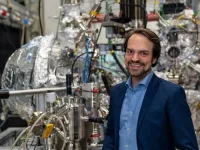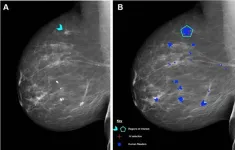(Press-News.org) While conventional silicon-based solar cells have had an unmistakable impact on the buildout of renewable energy resources around the world, additional performance improvements have become increasingly difficult to make as the devices approach their practical efficiency limits. This constraint has prompted scientists to seek out new technologies that can be combined with silicon cells to unlock higher efficiencies.
Solar cells made with crystals called perovskites are one such technology that have rapidly emerged as an appealing low-cost add-on, but perovskite cells are notoriously susceptible to voltage-induced changes — the shade cast from an overhanging tree branch or nearby plant can zap an entire module within minutes.
Now, researchers from Princeton University and the King Abdullah University of Science and Technology (KAUST) have connected the well-established silicon solar cell with the up-and-coming perovskite in a tandem solar cell to not only boost overall efficiency, but also to strengthen stability. The results, reported in Joule on Sep. 5, illustrate that the connection protects the frail perovskite solar cell from voltage-induced breakdown while attaining greater efficiencies than either cell can achieve on their own.
“Tandem solar cells have already demonstrated power conversion efficiencies that are greater than either silicon or perovskite solar cells alone,” said Barry Rand, research leader and professor of electrical and computer engineering and the Andlinger Center for Energy and the Environment. “We thought that in addition to their higher efficiencies, tandem solar cells could also solve some of the stability challenges facing perovskites by linking them with silicon cells, which are much more stable.”
To test their hypothesis, the researchers built three strings of solar cells: one containing only silicon solar cells, one with only perovskites, and one composed of tandem solar cells, with the two technologies connected in a series. The researchers then shaded one of the cells in the string to simulate the partial shading conditions that a solar array may encounter at least once in its decades-long lifespan.
Such partial shading usually spells doom for perovskites, as the still-illuminated cells force charge to flow through the now-shaded and inactive cell, quickly degrading both it and the entire module. Silicon solar cells, on the other hand, are much more resilient to voltage fluxes, and can endure periods of partial shading with fewer issues.
As expected, the perovskite-only solar module quickly deteriorated after partial shading, while the silicon solar module was only minimally impacted. Interestingly, however, the tandem solar module was just as resilient as the silicon-only module, implying that by connecting the two solar technologies, the silicon cell was able to mask the frailty of the perovskite.
“When you combine two different materials to form a final product, usually it’s the weakest link that ends up determining the overall strength of the chain,” said co-author Stefaan De Wolf, professor of material science and engineering at KAUST. “But in this case, it’s actually the stronger component that protected the weaker one.”
The researchers said their findings demonstrate that partial shading — which has been a major obstacle to perovskite-only modules — may be a negligible concern for series-connected tandem solar devices.
The team also said that the findings bode well for the commercialization prospects of perovskites, because they imply that perovskites may have the most potential when deployed in complement with silicon solar cells, for which a mature manufacturing ecosystem already exists. Instead of having to build a competing manufacturing process, perovskites could be added onto the commercially proven production process for silicon solar cells.
While the team noted that several challenges in addition to partial shading remain to be solved before tandem solar cells achieve the lifespan expected of commercial solar technologies, such as their poor resilience to heat, they said that tandem devices could enable solar research to continue evolving after silicon solar cells hit their upper power conversion efficiency limits.
“If some other stability challenges can be solved, tandem solar cells could essentially take an already successful commercial technology and make it even better,” Rand said. “Our results make a strong case that tandem devices should be an all-hands-on-deck area for future solar research.”
The paper, “Reverse-bias resilience of monolithic perovskite/silicon tandem solar cells,” was published September 5 in Joule. In addition to Rand and De Wolf, co-authors include Zhaojian Xu of Princeton; Helen Bristow, Maxime Babics, Badri Vishal, Erkan Aydin, Randi Azmi, Esma Ugur, Bumin Yildirim, and Jiang Liu of the KAUST Solar Center; and Ross Kerner of the National Renewable Energy Laboratory (NREL).
The work was supported by KAUST under contract numbers OSR-CRG2020-4350, OSR-CARF/CCF-3079, and OSR-CRG2022-5035. The research was authored in part by NREL under contract number DE-AC36-08GO28308, and the researchers also received support from NREL’s Laboratory Directed Research and Development (LDRD) program.
END
Linking two solar technologies is a win-win for efficiency and stability
2023-09-05
ELSE PRESS RELEASES FROM THIS DATE:
Why are male kidneys more vulnerable to disease than female kidneys? USC Stem Cell-led mouse study points to testosterone
2023-09-05
Female kidneys are known to be more resilient to disease and injury, but males need not despair. A new USC Stem Cell-led study published in Developmental Cell describes not only how sex hormones drive differences in male and female mouse kidneys, but also how lowering testosterone can “feminize” this organ and improve its resilience.
“By exploring how differences emerge in male and female kidneys during development, we can better understand how to address sex-related health disparities for patients with kidney ...
Racial and socioeconomic differences still determine survival rates of premature babies in the US
2023-09-05
The US continues to face stark inequalities in preterm birth and mortality rates between mothers of differing socioeconomic status and race, finds a new report led by UCL researchers.
The study, published in JAMA Paediatrics, examined data from the US National Centre for Health Statistics Birth Infant/Death Dataset, of over 12 million preterm infant births over the course of 25 years, between 1995 and 2020.
Preterm birth is defined as any infant born before 37 weeks and is the leading cause of infant death ...
3D-printed ‘living material’ could clean up contaminated water
2023-09-05
Researchers at the University of California San Diego have developed a new type of material that could offer a sustainable and eco-friendly solution to clean pollutants from water.
Dubbed an “engineered living material,” it is a 3D-printed structure made of a seaweed-based polymer combined with bacteria that have been genetically engineered to produce an enzyme that transforms various organic pollutants into benign molecules. The bacteria were also engineered to self-destruct in the presence ...
KMOU scientists develop an energy-efficient wireless power and information transfer system
2023-09-05
Industrial Internet of Things (IIoTs) refers to a technology that combines wireless sensors, controllers, and mobile communication technologies to make every aspect of industrial production processes intelligent and efficient. Since IIoTs can involve several small battery-driven devices and sensors, there is a growing need to develop a robust network for data transmission and power transfer to monitor the IIoT environment.
In this regard, wireless power transfer is a promising technology. It utilizes radio frequency signals to power small devices that consume minimal power. Recently, simultaneous wireless information ...
ERC starting grants: 400 bright minds awarded over €628 million
2023-09-05
This funding, part of the EU’s Horizon Europe programme, will be invested in scientific projects spanning all disciplines of research. For example, a geochemist in the Netherlands will study Venus’ atmosphere to better understand habitability beyond Earth; a computer scientist in Germany seeks to make virtual reality more inclusive to physically disabled people; a geneticist in the UK aims to analyse parasites that cause malaria; and a researcher in Israel is set to investigate how algorithms are used at work to supervise employees.
ERC President Professor Maria Leptin said: “It is part of our mission to give early-career talent the independence to pursue ambitious ...
Dr. Niels Schröter wins ERC Starting Grant
2023-09-05
This is the first ERC Starting Grant to be hosted at the Max Planck Institute of Microstructure Physics. ChiralTopMat aims to provide the direct experimental observation of chiral spin-hedgehogs in structurally chiral crystals and to explore ways to control their properties for applications in magnetic memory devices. Moreover, another focus will be to test the stability of topological Berry curvature monopoles against strong electronic interactions that Schröter’s group recently discovered in a chiral topological semimetal, a material that combines structural ...
AI performs comparably to human readers of mammograms
2023-09-05
OAK BROOK, Ill. – Using a standardized assessment, researchers in the UK compared the performance of a commercially available artificial intelligence (AI) algorithm with human readers of screening mammograms. Results of their findings were published in Radiology, a journal of the Radiological Society of North America (RSNA).
Mammographic screening does not detect every breast cancer. False-positive interpretations can result in women without cancer undergoing unnecessary imaging and biopsy. To improve the sensitivity and specificity of ...
Perspective: Building megaprojects on time and under-budget
2023-09-05
A Perspective sheds light on why megaprojects take so long and cost so much—and what can be done to prevent the problem. Why did Boston’s “Big Dig” building project go 19 billion dollars over budget and take 9 years longer than anticipated? Globally, between $6 trillion and $9 trillion is spent on megaprojects every year, including everything from space telescopes to wind farms. In the United States, the recently passed $1 trillion infrastructure bill means a new era of megaprojects is at hand. In a Perspective, Guru Madhavan and colleagues review the causes behind ballooning costs and extended timelines for such megaprojects. Problems include premature ...
Can an artificial nose detect food spoilage?
2023-09-05
Researchers have developed an energy-efficient computing-based chip with smell-sensing units that can detect food spoilage and provides real-time conditions continuously throughout the spoilage process. The system is described in a study published in Advanced Science.
Other electronic noses, or artificial olfactory systems (AOSs), have been developed in the past, but they have numerous limitations, including high energy consumption, time delays, and data loss.
The AOS developed in this study requires little energy and integrates sensing and computing units on the same chip. It detects food spoilage by employing thin zinc oxide ...
Scammers can abuse security flaws in email forwarding to impersonate high-profile domains
2023-09-05
Sending an email with a forged address is easier than previously thought, due to flaws in the process that allows email forwarding, according to a research team led by computer scientists at the University of California San Diego.
The issues researchers uncovered have a broad impact, affecting the integrity of email sent from tens of thousands of domains, including those representing organizations in the U.S. government–such as the majority of U.S. cabinet email domains, including state.gov, ...





